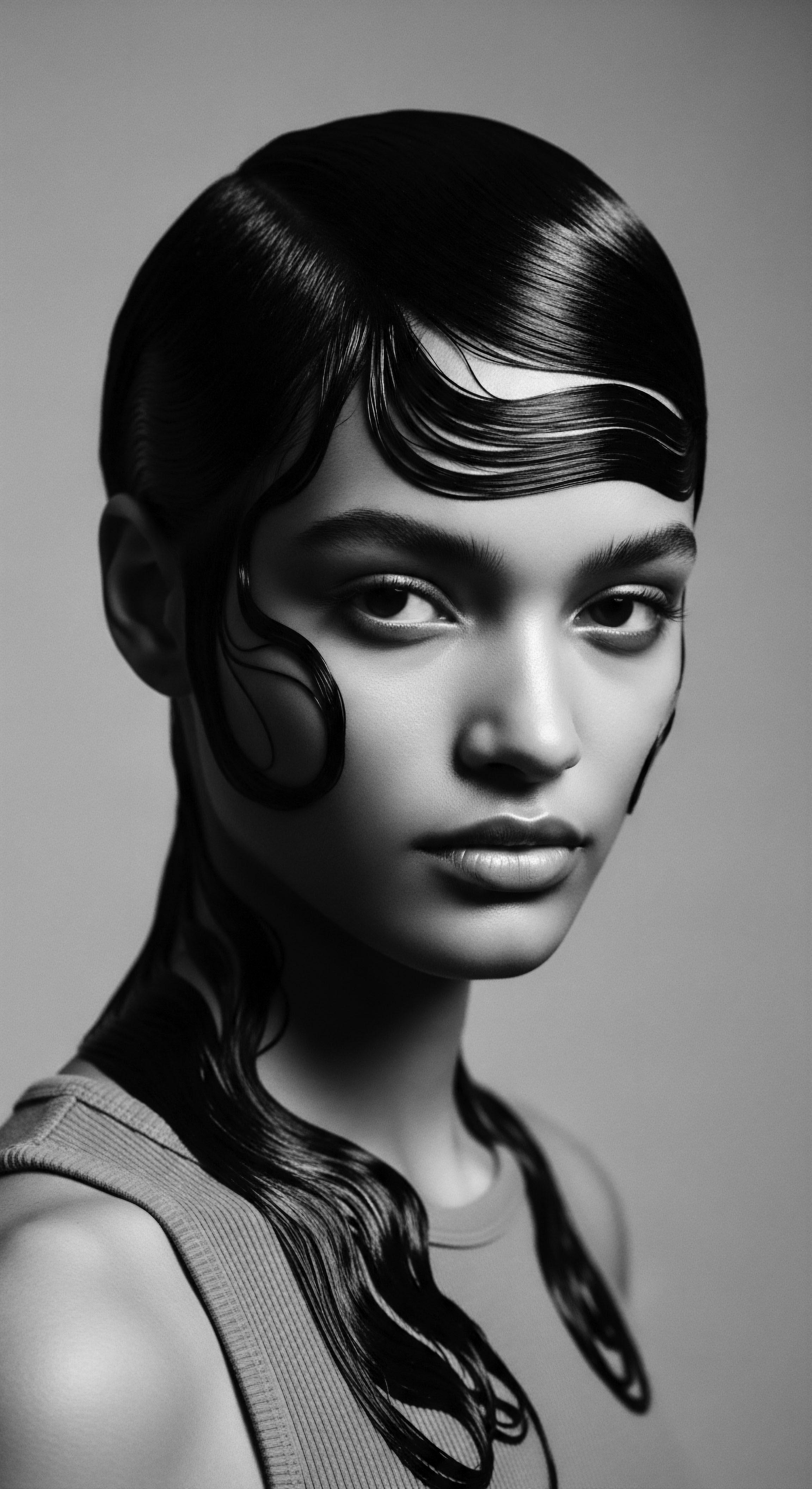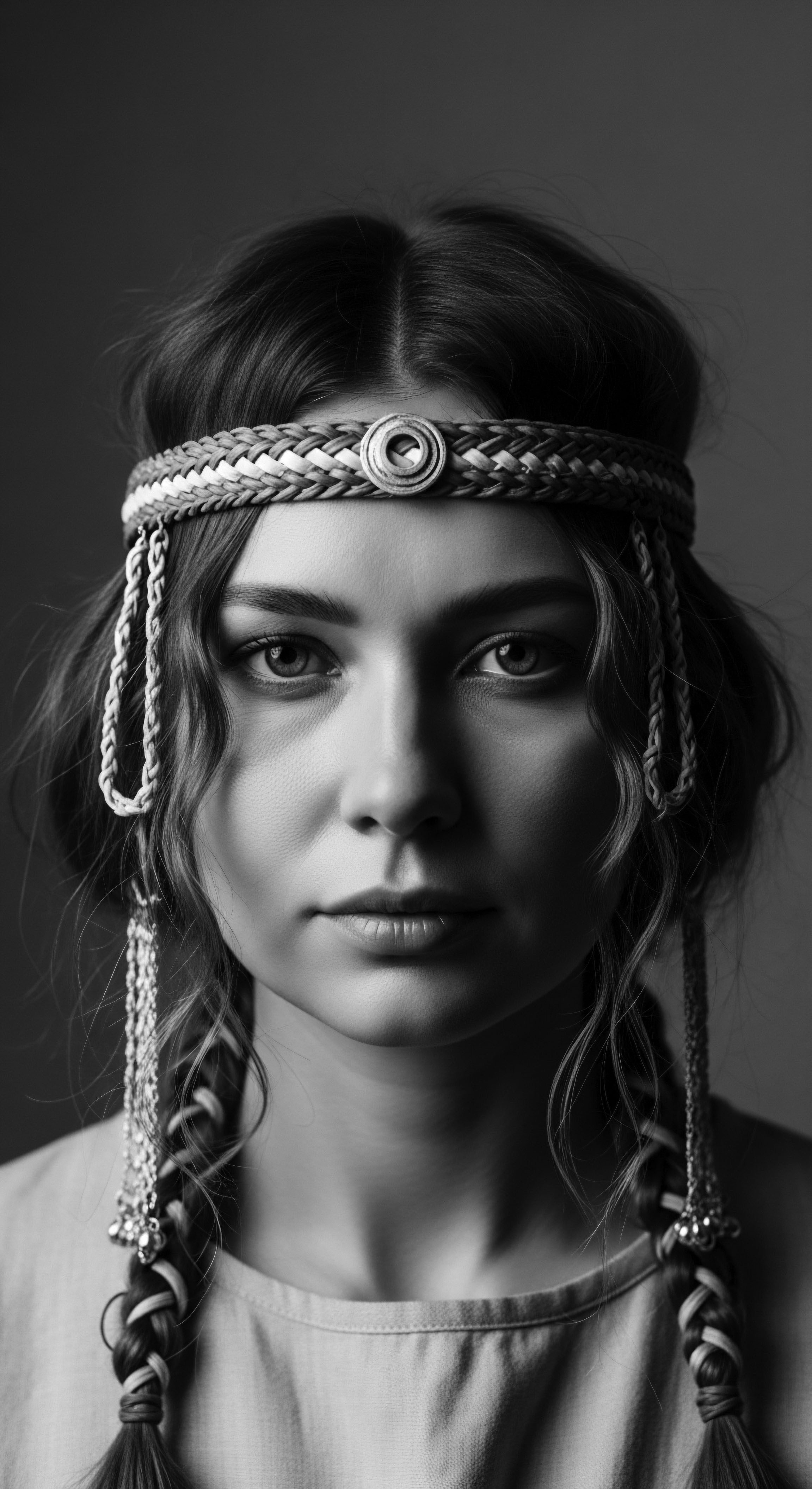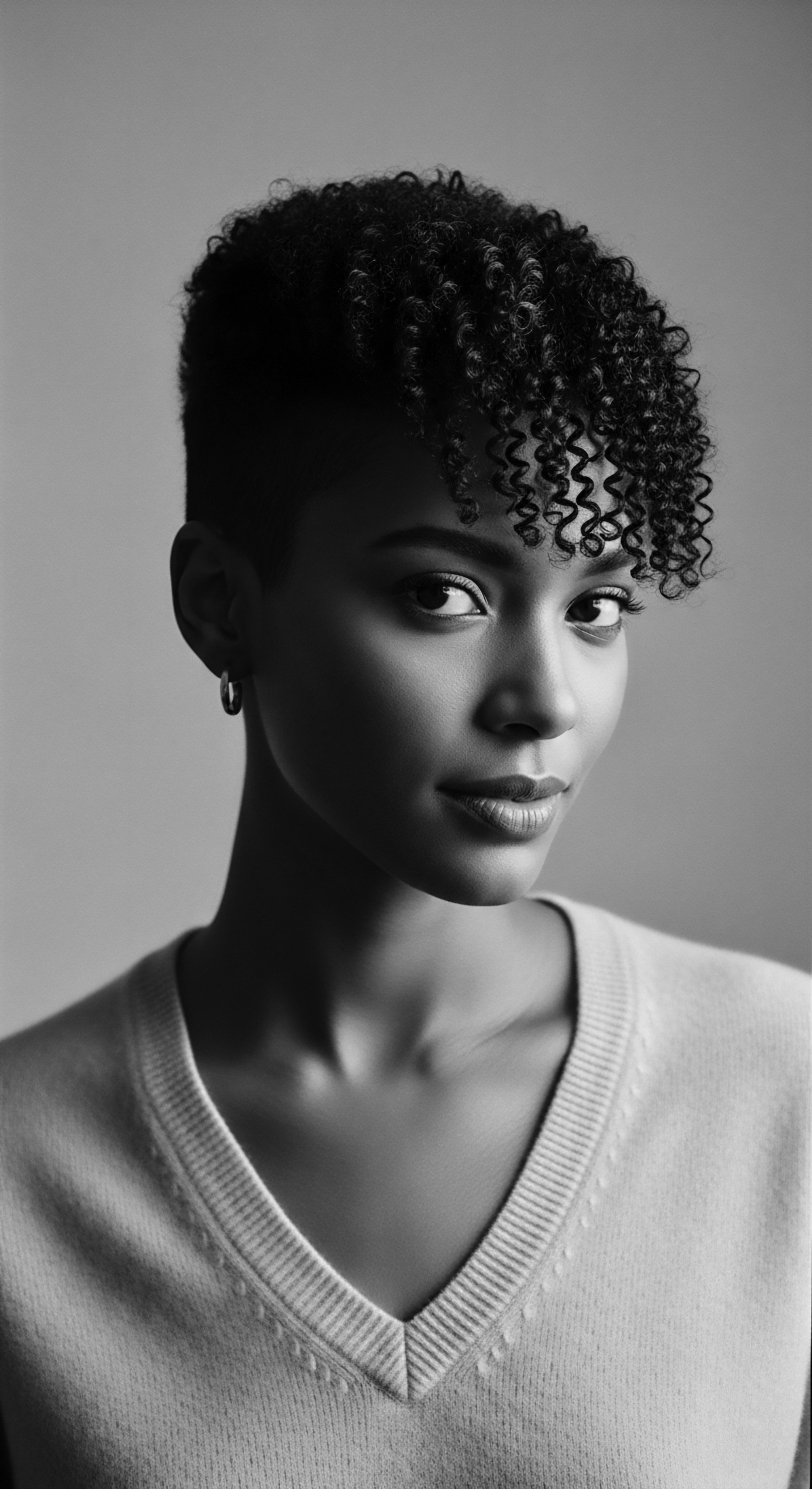
Roots
In the vast, verdant expanse where ancestral memories linger, where the very soil whispers tales of resilience and artistry, textured hair stands as a living chronicle. It is more than mere protein strands; it is a profound connection to lineage, a testament to enduring wisdom. For generations, the care of textured hair has been an intimate dialogue with heritage, a practice rooted in understanding its unique biology and honoring its place in collective identity. From ancient riverbanks to bustling marketplaces, methods of hair preservation were not simply functional; they were acts of reverence, echoing through time to shape our routines today.
The journey to comprehend how ancestral methods persist in contemporary textured hair care begins with acknowledging the very nature of the hair itself. Textured hair, particularly that of Black and mixed-race communities, possesses a distinct helical structure, prone to dryness and breakage if not tended with mindful hands. This inherent quality, a gift of genetic diversity, necessitates approaches that prioritize moisture retention, delicate handling, and protective measures. Our foremothers and forefathers understood this intuitively, crafting ingenious solutions from their environments, solutions that science now validates with keen observation.

What Ancestral Hair Anatomy Insights Still Matter Today?
The architecture of a single strand of textured hair reveals a remarkable story. Its elliptical shape and varied curl patterns — from broad waves to tight coils — predispose it to lift from the scalp, allowing for air circulation but also increasing its susceptibility to moisture loss. The cuticle, the outer protective layer, is often raised in textured hair, making it more vulnerable to external stressors and friction. Ancestral communities, without microscopes or chemical analyses, recognized these vulnerabilities.
They observed that hair thrived when kept moisturized, when manipulations were minimized, and when protected from the elements. This observational science, honed over millennia, laid the groundwork for modern understanding.
The intrinsic helical structure of textured hair necessitates specific preservation techniques rooted in historical observation and cultural adaptation.
Consider the emphasis on oils and butters in traditional African hair care. Ingredients like Shea Butter (Butyrospermum parkii), Coconut Oil (Cocos nucifera), and Argan Oil (Argania spinosa) were not chosen at random. They were selected for their emollients and occlusive properties, their ability to seal moisture within the hair shaft, and provide a protective barrier. These natural bounties, abundant in various African regions, became foundational elements of regimens.

Hair Classification and Its Heritage Context
While modern classification systems like Andre Walker’s typing (1A-4C) aim to categorize curl patterns, ancestral communities possessed a more fluid and culturally embedded understanding of hair types. Their distinctions were often tied to familial lineage, tribal affiliation, and even the spiritual essence of the individual. Hair was read as a map of identity, a visual language. For example, specific braiding patterns or the way hair was adorned could signify marital status, age, social standing, or ethnic group.
This historical perspective reminds us that hair classification extended beyond mere texture; it encompassed the social and spiritual dimensions of hair. The value placed on healthy, well-preserved hair was universal across these classifications, regardless of the specific coil or wave pattern. The goal remained the same ❉ to support the hair’s vitality and length.

The Lexicon of Ancestral Hair
The language surrounding textured hair care is rich with terms that carry historical weight. Concepts such as Protective Styling, for instance, are deeply rooted in ancestral practices. Braids, twists, and locs, far from being recent trends, date back thousands of years in African cultures. These styles were designed to shield the hair from environmental damage, reduce manipulation, and retain length.
Another profound concept is the idea of hair as a spiritual conduit. In many African societies, hair was believed to connect individuals to their ancestors and the divine, thus requiring respectful and mindful care. This perspective underscores that hair preservation was never just cosmetic; it was a holistic practice interwoven with spiritual wellbeing and community identity.

Ritual
The daily and ceremonial interactions with textured hair, passed down through generations, transformed simple acts of care into profound rituals. These were not arbitrary steps, but deeply considered practices honed by collective experience and ancestral wisdom. They spoke to a profound understanding of the hair’s unique needs, aiming to preserve its health and longevity through mindful application of natural resources and skilled handiwork. From the communal act of styling to the solitary moments of night care, these traditions were imbued with meaning.

Protective Styling as an Ancestral Art?
The enduring legacy of protective styling stands as a cornerstone of textured hair heritage. Braids, cornrows, twists, and locs were not merely aesthetic choices in pre-colonial African societies; they served vital practical and symbolic functions. They shielded delicate strands from the harsh sun, dust, and daily friction, minimizing breakage and promoting length retention. Beyond protection, these styles were powerful markers of identity, communication, and social standing.
For instance, archaeological evidence from ancient Egypt shows elaborate braided wigs, denoting status and religious beliefs. In West African cultures, specific braid patterns could convey a person’s age, marital status, or even tribal affiliation. The Himba tribe in Namibia, for example, traditionally coats their hair with otjize, a mixture of ochre, butterfat, and herbs, then styles it into thick braids or locs, offering protection from the elements while signifying connection to their land and ancestors.
During the transatlantic slave trade, the practice of braiding assumed another layer of profound significance. Enslaved Africans, stripped of their names and lands, often used cornrows as a means of communication, sometimes even embedding rice seeds within them for survival during their arduous journeys. This demonstrates a deep continuation of ancestral hair practices as a form of cultural continuity and resistance, a testament to profound human spirit.
- Cornrows ❉ Intricately braided close to the scalp, originating in ancient Africa, used to convey social status, marital status, and ethnic identity.
- Bantu Knots ❉ Coiled sections of hair secured against the scalp, with roots among the Zulu people of South Africa, valued for their ability to stretch and protect hair.
- Hair Threading ❉ Known as “Irun Kiko” among the Yoruba people, a technique using flexible threads to wrap hair sections, aiding length retention by preventing breakage.

Traditional Natural Styling and Definition
Beyond highly structured protective styles, ancestral communities also practiced methods to enhance and define hair’s natural curl patterns, all while maintaining its health. The use of natural substances for conditioning and shine was widespread.
Consider the use of herbal rinses. Various leaves and plant extracts were steeped in water to create rinses that cleansed the scalp, softened hair, and imparted a subtle sheen. These botanical elixirs, free from harsh chemicals, helped maintain the hair’s inherent moisture balance and integrity. The wisdom of these practices, focused on gentle care and natural ingredients, continues to inform many contemporary ‘natural hair’ routines that prioritize minimal intervention and maximum nourishment.
The use of wide-toothed combs, crafted from wood or bone, was also common. These tools facilitated gentle detangling, minimizing breakage on delicate textured strands. This thoughtful selection of tools reflects an early understanding of how best to handle hair that is prone to tangling and damage. The modern emphasis on finger-detangling or using specific wide-tooth combs directly echoes these ancestral inclinations.
| Ancestral Practice Braiding and Twisting |
| Description and Heritage Link These fundamental techniques, dating back millennia in African cultures, served as a means of social identification, spiritual expression, and primarily, hair protection, minimizing exposure and breakage. |
| Modern Application or Validation Contemporary protective styles (box braids, twists, cornrows) continue to reduce manipulation and retain length, serving as a popular choice for hair health. |
| Ancestral Practice Hair Threading (Irun Kiko) |
| Description and Heritage Link A West African tradition, particularly among the Yoruba, where hair is wrapped tightly with threads. This method stretched hair without heat, preparing it for styling and preserving its condition. |
| Modern Application or Validation Modern "heatless stretching" methods and tension styling techniques echo this ancestral wisdom, allowing for hair lengthening without thermal damage. |
| Ancestral Practice Oiling and Sealing |
| Description and Heritage Link The consistent application of natural oils and butters like shea, coconut, and castor to scalp and strands was central to preventing dryness and improving elasticity. |
| Modern Application or Validation Today's L.O.C./L.C.O. methods (Liquid, Oil, Cream) directly apply the principle of layering moisture and sealing it with emollients for optimal hydration. |
| Ancestral Practice These ancestral practices exemplify a deep understanding of textured hair's unique needs, guiding modern routines toward greater preservation. |

Relay
The enduring vitality of ancestral hair preservation methods within contemporary textured hair routines speaks to a remarkable transmission of wisdom across epochs. This continuity is not merely a matter of historical curiosity; it is a living, breathing testament to the efficacy of practices born of observation and necessity, practices that modern science increasingly affirms. The interplay between ancient remedies and current understanding allows for a deeper appreciation of the profound ingenuity embedded in these heritage practices.

Building Personalized Routines with Ancient Wisdom
The concept of a personalized hair regimen, seemingly a modern innovation, has deep roots in ancestral wellness philosophies. Traditional communities understood that hair care was not a one-size-fits-all endeavor; it was tailored to individual needs, environmental factors, and the specific life stage of the person. This meant selecting ingredients based on local availability and observed efficacy, often within a holistic framework that considered overall bodily health.
For example, the widespread use of various natural oils and butters across African communities was not accidental. In arid regions, emollients like Shea Butter and Marula Oil (Sclerocarya birrea) offered significant protection against dryness and sun exposure, while in more humid climates, lighter oils might have been favored. Today, this translates to the practice of customizing product choices based on hair porosity, density, and environmental conditions, a direct echo of ancestral responsiveness.
The practice of tailored hair care, adapting to individual needs and local resources, is an ancient concept continually applied in contemporary textured hair regimens.
A compelling instance of this ancestral scientific application comes from the Bassara/Baggara Arab tribe of Chad. For generations, Bassara women have utilized a paste made from Chebe Powder (Croton gratissimus) to retain exceptional hair length. This ritual involves coating the hair strands with a mixture primarily composed of Chebe seeds, along with cherry seeds and cloves, then braiding the hair.
Nsibentum, a hair specialist from Congo-Brazzaville, notes that the Chebe practice is effective not because it stimulates hair growth directly, but because it significantly enhances length retention by filling hair shaft spaces and sealing the cuticle, thereby preventing breakage. This traditional method, sustained over centuries, aligns with modern scientific understanding of hair cuticle health and protein retention. The focus on preserving existing length rather than solely promoting new growth showcases a sophisticated, almost preventative, approach to hair care that contrasts with the often growth-obsessed narratives of contemporary consumerism. This case exemplifies how ancestral knowledge, though developed without formal scientific tools, accurately addressed the biomechanical needs of textured hair.

The Nighttime Sanctuary and Bonnet Wisdom
The practice of protecting hair at night is a critical aspect of preserving textured hair health, and its heritage is profoundly intertwined with head coverings. While the modern hair bonnet gained prominence in the 20th century as an accessible tool for Black women to protect their intricate hairstyles and natural textures, its roots run deeper.
Headwraps, known as Dukus or Doeks in various African countries, have been traditional attire for centuries, serving not only as fashion statements but also as practical means of hair protection from the elements, indicators of social status, and even expressions of emotional state. During the era of enslavement, headwraps and later bonnets became symbols of resilience for African American women, offering a way to shield their hair from harsh conditions while subtly defying imposed beauty standards.
The science behind this tradition is clear ❉ materials like silk or satin, often favored for bonnets and headwraps, reduce friction between hair strands and coarser fabrics like cotton pillowcases. This minimization of friction prevents tangling, breakage, and moisture loss, preserving the hair’s natural oils and style. The ancestral understanding of reducing nightly disturbance to hair, whether through simple cloth wraps or more elaborate coverings, directly informs the contemporary mandate for sleep protection to maintain hair integrity.

Ingredient Wisdom for Textured Hair
The ancestral pharmacopeia for textured hair care was vast, drawing directly from the natural world. Many traditional ingredients, chosen for their observed benefits, continue to be celebrated in modern formulations due to their inherent properties that address the specific needs of textured hair.
- Shea Butter (Butyrospermum parkii) ❉ Extracted from the nuts of the shea tree, this rich butter has been used for centuries across West Africa for its deep moisturizing and protective qualities, shielding hair from sun and environmental damage.
- African Black Soap ❉ A traditional cleanser from West Africa, made from plantain skins, palm leaves, and cocoa pods, offering gentle cleansing without stripping hair of moisture.
- Chebe Powder (Croton gratissimus) ❉ Hailing from Chad, this herbal mixture is famous for its role in length retention by nourishing the hair shaft and sealing in moisture.
- Castor Oil (Ricinus communis) ❉ Popular in various African and diasporic communities, particularly Jamaican Black Castor Oil, it is valued for its thick consistency, purported ability to promote growth, and its humectant properties.
- Manketti Oil (Schinziophyton rautanenii) ❉ Also known as Mongongo oil, sourced from Southern Africa, this emollient oil protects hair from dry climates and is used in traditional hair treatments.
These ingredients are not simply cultural relics; they are scientifically sound choices for textured hair. Their fatty acid profiles, antioxidant content, and emollient qualities directly address common challenges like dryness, brittleness, and breakage. The ancestral knowledge of these plants and their applications represents a sophisticated botanical science, passed through oral traditions and practical application. Modern product development often seeks to isolate and synthesize compounds from these very same natural sources, validating the wisdom of our forebears.

Holistic Influences on Hair Health
Ancestral wellness philosophies rarely isolated hair health from overall bodily and spiritual wellbeing. Hair was seen as an extension of one’s inner state, influenced by diet, emotional peace, and communal harmony. This holistic perspective contrasts sharply with modern, often fragmented, approaches to beauty.
Traditional diets, rich in nutrient-dense foods, naturally supported hair vitality. The communal aspects of hair care—gathering to braid, share stories, and pass down techniques—also contributed to mental and social wellbeing, reducing stress which can impact hair health.
The practice of regular scalp massage, often performed with nourishing oils, was widespread. This manual stimulation was believed to improve circulation to the scalp, promoting a healthy environment for hair growth. Modern trichology confirms the benefits of scalp massage for blood flow and nutrient delivery to hair follicles. These subtle yet profound connections illustrate how ancestral methods always viewed hair care as an integrated part of a thriving life, a legacy that continues to inspire genuine wellness in our routines today.

Reflection
The echoes from our ancestral past reverberate with profound clarity in the rituals and rhythms of textured hair care today. Each coil, each strand carries within it the memory of hands that nurtured, protected, and celebrated, stretching back across continents and through the veil of time. The practices of our foremothers and forefathers were not simply pragmatic responses to biological realities; they were acts of profound cultural preservation, acts that allowed identity to flourish even in the face of immense adversity.
From the deliberate art of protective styling that shielded delicate tresses, to the thoughtful application of botanical treasures from the earth, and the sacred reverence for hair as a spiritual anchor, the wisdom of ancient methods remains a living force. Our bonnets and silk pillowcases today stand as continuations of headwraps that spoke volumes without uttering a sound, protecting not just hair but dignity. The oils and butters we seek are direct descendants of the nourishing balms concocted centuries ago, their efficacy now understood through the lens of modern science yet always rooted in intuitive knowledge.
Textured hair heritage is not a static artifact; it is a dynamic, evolving narrative. It reminds us that our contemporary routines are part of a continuous story, a testament to resilience, creativity, and self-love that transcends generations. To care for our textured hair with intention, drawing from these deep wells of ancestral wisdom, is to partake in a sacred dialogue, honoring those who came before us and laying a strong foundation for those who will follow. It truly is the soul of a strand, stretching unbound across time.

References
- Ache Moussa. (2024, July 3). Ancestral hair-paste ritual gains new life in Chad. Premium Beauty News.
- Gomez, L. (2018). Hair and Identity in the Mursi Tribe ❉ A Sociocultural Study. University of Anthropological Studies Press.
- Sherrow, V. (2001). Encyclopedia of Hair ❉ A Cultural History. Greenwood Press.
- Tharps, L. & Byrd, A. (2001). Hair Story ❉ Untangling the Roots of Black Hair in America. St. Martin’s Press.
- Rosado, T. (2003). The Grammar of Hair ❉ Hair Practices and Identity in the Black Diaspora. Academic Press.
- Zeleza, P. T. (2005). The African Diaspora ❉ A History Through Culture. Indiana University Press.
- Gomez, L. (2018). Ethnographic Study of Mursi Women’s Hair Weaving Practices. Journal of Cultural Anthropology.
